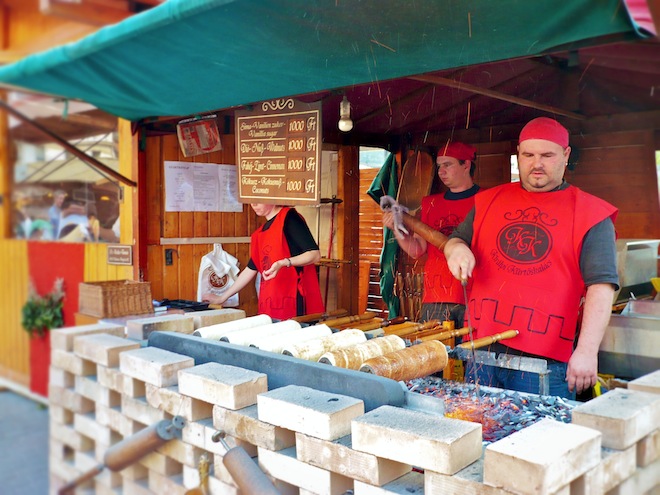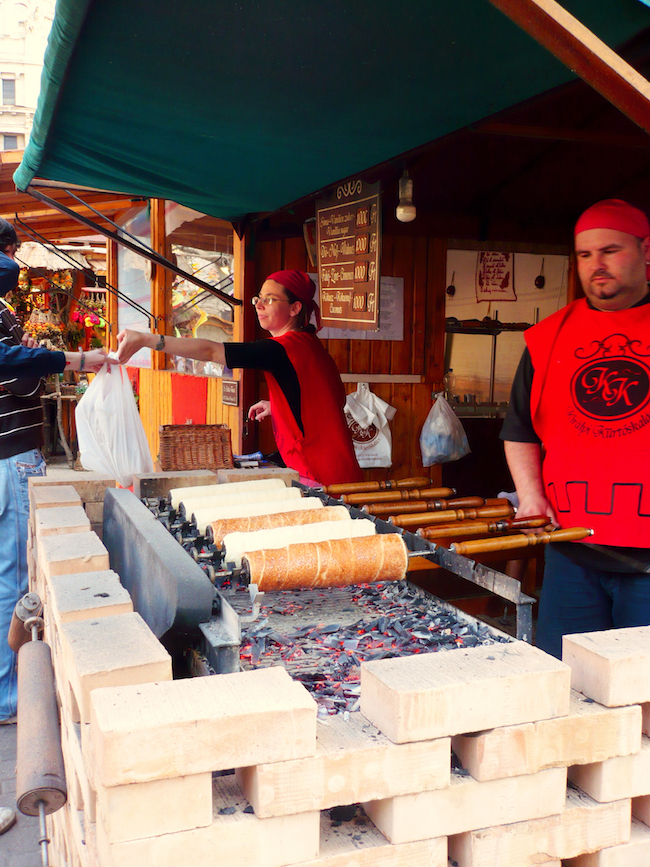
In the picture above you can see a man in Budapest making Kürtőskalács (I know, I don’t even attempt to pronounce it). In spite of its unfriendly name, this bread is a heavenly sweet treat made from sugar, wheat flour, butter, milk, eggs, yeast, and salt. The yeast dough (raised dough) is made into a strip which is spun and then wrapped around a truncated cone and rolled in granulated sugar.
The kürtőskalács (chimney cake) is baked above charcoal cinders while greased with melted butter until its surface gets a golden-brown color. During the baking process, the sugar stuck on kürtőskalács becomes a caramel and forms a shiny, crispy crust on the bread. The surface can then be sprinkled with additional toppings like ground walnuts or cinnamon powder.

When I was strolling the streets of Budapest, the smell and the vision of this bread caught my attention and I had to try it. I picked a cinnamon powdered one and devoured it. One was enough to share between two people. The freshly warm chewy baked bread was absolutely heavenly.
History
The origins of the Kürtőskalács date back to medieval times from a manuscript around 1450 but the first known recipe originates from Transylvania, in the 1784 cookbook of Countess Mária Mikes of Zabola. But it has no mention of any sweetness. About 10 years later, in 1795 a recipe from Kristóf Simai’s cookbook in Upper Hungary (present-day Slovakia) first mentioned “sweetening subsequent to baking”.
Almost 100 years passed before the first mention was made of the next step in the evolution of kürtőskalács, the appearance of a caramelized sugar glaze, in Aunt Rézi’s 1876 Cookbook, published in Szeged, Hungary. The recipe suggests “sprinkling sugar (sugar almond) on dough on spit prior to baking”. I think we all ought to thank Terézia Dolecskó, the writer of this cookbook.

The kürtőskalács can be mainly found in Hungarian-speaking regions including Hungary, Serbia, Romania, Slovakia, Slovania and Ukraine. You may also find it by the name of Trdelník and variations of it such as the German Baumkuchen, Polish sękacz and Lithuanian šakotis.
If you ever come across a kürtőskalács, please buy two. One for you and a friend and a second one in my honor. If you eat both you only get the calories of one if you do the other one in my honor. The calories will travel across light and find me, don’t worry.
See related: Noteworthy European Destination in Photos: Budapest, Hungary

YUM YUM YUM!! We thought the Hungarian word was unfriendly…until we saw the Czech name for it: trdelnik – LOL
This is one of our favourite sweet treats 🙂
LikeLiked by 1 person
that looks good – I miss European food!
LikeLike
Yummy! I wouldn’t be able to say it but i would definitely like to eat it. 🙂
LikeLike
Oh I love these pastries! We learnt about them in Czech, so for me they are trdelniki :))
LikeLike
The Czech word is way easier than the Hungarian haha.
LikeLiked by 1 person
Think so too 🙂
LikeLike
Very interesting and an amazing way to bake bread! How do they release the baked rolls from the roller? I am totally intrigued by this process and from you description the bread is drool worthy!
LikeLike
The cylinders can be detached, so the bread just slides off 🙂
LikeLike
From the initial picture on the reader list I thought these treats were approx same size at a hot dog – but looking at the rest of the pictures I can fully understand one is enough to share! 😀
LikeLike
I found a place that makes these in Auckland, New Zealand a couple of weeks ago! Yum!
LikeLike
Oh wow really? yummy! What do they call them? Is it locals making them?
LikeLike
They were advertised as chimney cakes. They also made Langos (deep fried dough with cheese and sour cream on top). It was just a little food stall in Elliot Street. I think she might have been Hungarian originally, but sounded like she had been in NZ for a while.
LikeLike
Oh I see 🙂 I’d love to run into one here.
LikeLike
You could start one… 😉
LikeLike
Haha good idea, and I should practice a Hungarian accent. My appearance allows me to pass as many different nationalities 😉 People often are not sure where I’m from.
LikeLike
I think I must sort of have an appearance like that too – in lots of countries people spoke to me in the local language until I looked confused. And sometimes those people were other tourists!
LikeLike
I did a write up on the Czech variation of this back in December:
https://beyondprague.wordpress.com/czechs-and-czech-culture/food-drink/trdelnik-the-czech-treat-that-isnt/
Through my research, i learned that chimney cakes are pretty common throughout Europe and take quite a few different forms.
LikeLike
The one I saw in Budapest was my first and only one I’ve tried so far :p But when I did my research I learned what you just said that variations of it are available in different countries in Europe .
LikeLike
True; from pictures I saw in my research, the Scandinavian versions were quite different and looked more like true cake than bread.
LikeLike